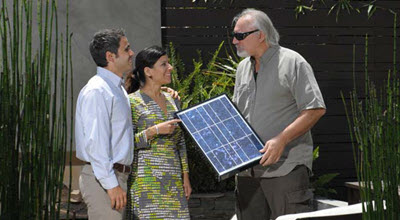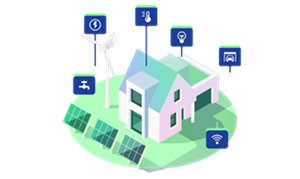Residential customers who enroll in the Solar Billing Plan will be transitioned to the TOU-D-Prime rate and will be charged the full retail rate for all energy that they consume. For more information on the TOU-D-Prime rate, visit Time-Of-Use Residential Rate Plans.
Solar Billing Plan

A New California Solar Program is Here
The Solar Billing Plan (SBP) is a new program for customers who apply for interconnection of an eligible renewable generating system, such as solar or wind, after April 14, 2023. The Solar Billing Plan succeeds the Net Energy Metering (NEM) 2.0 program.
How The Solar Billing Plan Works
For customers considering solar and other renewable generation1 at their homes, the Solar Billing Plan is designed to help modernize solar rates to promote grid reliability, incentivize solar and battery storage, and help control electricity costs for all Californians. Each month, billing will include charges for energy used from the electric grid, as well as energy credits exported to the grid.
1 Renewable generation includes solar, wind, renewable gas, and other technologies that satisfy the CEC Renewable Portfolio Standard (RPS) qualifications.

Getting Started with Solar
There are several things to consider once you make the decision to install your own renewable generator. Learn more about the steps for going solar.

Understanding Your Solar Bill
Learn how to read and understand your solar billing plan statements.
Charges and Export Credits
Learn more about Export Pricing and other Solar Billing Plan questions in our Help Center.
On the Solar Billing Plan, Energy Export Credits will be applied to the amount of electricity a customer exports to the grid and will reflect the electricity’s value to the electric grid during each hour of the day. Energy Export Credits will be calculated by taking the kilowatt hours generated by the customer’s generating system that is exported hourly to the grid multiplied by the Energy Export Credit prices. These EEC prices will vary hourly throughout the day and can be found here for both Pacific Time and Universal Time. Customers who enroll in the Solar Billing Plan before January 1, 2028, will have fixed EEC prices for the first nine years of operation. The nine years is referred to as the lock-in period.
Each year, the EEC Prices are calculated using the CPUC Avoided Cost Calculator (ACC) approved as of January 1 of the calculation year (the “vintage year”). For each “vintage year”, the simple average EEC Price is calculated for each month of a 9-year lock in period, and it is differentiated by hour (24 hours) and by weekdays and weekend/holidays. In addition, each hourly EEC Price is broken down in two components: (1) the Generation EEC Price (energy, cap and trade and generation capacity) component, and (2) the Delivery Service EEC Price (transmission, distribution, greenhouse adder and methane leakage) component.
EEC Factors (UTC) - CSV File
To encourage early adoption of the Solar Billing Plan, residential customers who enroll prior to 2028 are also eligible to receive an additional credit. Those enrolling in the first year of the program will receive an additional $0.04 per kWh for residential customers and $0.09 per kWh for low-income customers. Currently, three groups of customers are considered low-income:
- Residential customers who are enrolled in the CARE and FERA programs.
- Residential owners of single-family homes in Disadvantaged Communities, or
- Residential customers living in Tribal Communities.
To determine if you reside in a Disadvantaged Community, please visit the CalEPA website at SB535 Disadvantaged Communities 2022 (arcgis.com).
EEC Factors (UTC) - CSV File and Instructions
EE Factors (UTC) - Docx File and Instructions
Solar Application Processing Data
NEM and SBP applications are being reviewed on a first-come, first-served basis to ensure document requirements are met. If you are looking for SCE Solar Application Processing Data and the solar applications currently under review visit Net Energy Metering Updates.

Shop SCE's Marketplace
Visit SCE's Solar & Battery Marketplace to compare offers from top solar and energy storage companies.

What's the Difference?
Learn how NEM 2.0 and 1.0 are different from the Solar Billing Plan.

Solar Glossary
Want to learn to speak solar? Find common terms and definitions that are good to know as you go solar.

Frequently Asked Questions
Whether you want every detail or are seeking specific info, we’ve compiled frequently asked questions about the Solar Billing Plan so you can find the answers you need easily and quickly.

Submit Documents
Most contractors will apply on your behalf, but we've provided all the forms you'll need to submit to get interconnected and enrolled in the Solar Billing Plan.
